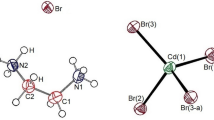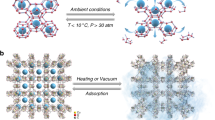Abstract
A stable hollow Li20B60 cage with D2 symmetry has been identified using first-principles density functional theory studies. The results of vibrational frequency analysis and molecular dynamics simulations demonstrate that this Li20B60 cage is exceptionally stable. The feasibility of functionalizing Li20B60 cage for hydrogen storage was explored theoretically. Our calculated results show that the Li20B60 molecule can adsorb a maximum of 28 hydrogen molecules. With a hydrogen uptake of 8.190 wt% and an average binding energy of 0.336 eV/H2, Li20B60 is a remarkable high-capacity storage medium.
Similar content being viewed by others
Introduction
Boron is an element of fascinating chemical complexity due to the multicenter bonds, which yield a wide range of boron structures from the usual three dimensional (3D) polyhedral geometries1 to one-dimensional (1D) nanotubes2,3 and the recently discovered B80 cage4, which is structurally analogous to C60 with 12 pentagonal and 20 hexagonal rings. The B80 cage has an additional boron atom at the center of each hexagon and has the same icosahedral point group symmetry as does the C60 fullerene. Based on first-principles calculations, several other fullerenes and stuffed fullerene-like structures have been proposed. Yan et al.5 constructed a series of stable B80+8k (0 ≤ k ≤ 5, k ≠ 1) fullerenes by using the modified leapfrog algorithm. Zope et al.6 demonstrated the existence of a family of stable boron fullerenes containing 80n2 (n = 1–5) atoms. Prasad et al.7 found that for B98, B99, B100, B101 and B102 clusters, the stuffed fullerenes built on icosahedral-B12 units, are more stable than the fullerene-like boron clusters.
In the course of ongoing studies of the geometric structures of Bn clusters, the design of boron-based nanomaterials is being closely examined for their applications in hydrogen storage8,9,10,11,12. Using first-principles calculations, the buckyball B80 coated with various metals M = Li, Na, K, Be, Mg, Ca, Sc, Ti and V has been investigated for hydrogen storage8,9,12. It has been found that Na and Ca appear to be the best candidates for hydrogen storage. The B80Na12 fullerene can store up to 72 H2 molecules with a gravimetric density of 11.2%8 while Ca12B80 can bind up to 66 H2 molecules with a hydrogen storage capacity of 9.0 wt%9. The hydrogen storage properties of planar boron sheets coated with alkali metals have also been investigated and the boron-Li system was found to be a good candidate for hydrogen storage purposes10. Ab initio studies of hydrogen adsorption in Li-doped hexagorane (B6H6Li2) were carried out by Srinivasu et al.11. They found each Li site can adsorb a maximum of three hydrogen molecules which corresponds to a gravimetric density of 12 wt%. More recent investigations of boron nanostructures have shown that Li-decorated boron sheets and nanotubes based on the boron double ring are potential hydrogen storage media12. These studies indicate that there is an exciting future for boron-based nanomaterials, specifically in low dimensional structures, which might lead to novel devices with diverse and unique properties13.
In the present work, we report that our first-principles calculations within density functional theory (DFT) have identified a stable Li20B60 cage. We have explored the feasibility for hydrogen storage and the results show that the hydrogen uptake of the Li20B60 molecule is 8.190 wt%, making it an attractive candidate as a high-capacity hydrogen storage material.
A large Li20B60 cage was constructed based on a Li-B sheet as shown in Fig. 1, which is stable and can maintain its original 2D configuration. After full relaxation, it was found that the Li20B60 cage obtained had robust stability and a nearly spherical shape with a D2 point group symmetry, as shown in Fig. 2(a). The binding energy of Li20B60 cage is −4.888 eV/atom, which is closely related to that of the Li-B sheet (−4.957 eV/atom). In this cage structure, the B atoms can be seen to form “truncated octahedrons” with the 20 Li atoms capping the fourteen faces. For the Li atoms, there are three different positions: six “face-centered” sites (LiI), four top sites on the “truncated faces” formed by the boron hexagons (LiII) and four top sites on the “truncated faces” formed by boron triangles (LiIII). On each “face-centered” site, there exists a Li2 dimer with an average Li-Li distance of 2.635 Å. Four Li atoms are located on the top sites of the “truncated face” formed by the boron hexagons. The remaining 4 Li atoms are located on the top sites of the boron triangles. We refer to these atoms below as LiI, LiII and LiIII, respectively, as shown in Fig. 2. The relative stability of this Li20B60 cage was discussed by comparing with other structures, which arose during the high-temperature dynamic simulations, but no lower-energy structures were found (see Figures S2 and S3 in the Supplementary Information).
(a) Configuration and (b) deformation electron density for the Li20B60 cage. In part (a), the purple, green and blue balls show the LiI, LiII and LiIII atoms, respectively and the two inside pictures explain the surrounding structures of LiII and LiIII. In part (b), the blue and yellow regions represent the positive and negative values of the charge density and the isosurface corresponds to 0.03 e/Å3.
The stability of Li20B60 was further checked using vibrational frequency analysis and molecular dynamics (MD) simulations. The vibrational frequency analysis of the Li20B60 cage indicates no imaginary frequencies and the highest intensity frequency was 687.9 cm−1. For more details see Section IV of the Supplementary Information, as well as some low-frequency modes. Therefore, the Li20B60 cage is kinetically stable. We also carried out ab initio molecular dynamics simulations with the constant-temperature, constant-volume (NVT) ensemble in a Massive Nosè-Hoover thermostat. The total simulation time was set to be 1.0 ps with 1000 dynamics steps. It was found that the structure of the D2-Li20B60 cage was not disrupted up to a temperature of ~600 K. These results indicate that D2-Li20B60 cage has good thermodynamic stability.
It is natural to explore the electronic structure of the Li20B60 cage. To this end, we calculated the deformation electron density, partial density of states (PDOS) and frontier molecular orbitals, including the highest occupied molecular orbital (HOMO) and the lowest unoccupied molecular orbital (LUMO) as shown in Figs 2(b) and 3. From the deformation electron density, one can see an alternation of three-center and two-center bonds on each of the six centered-faces of the “truncated octahedron”. On the “truncated faces” formed by the boron hexagons, there is obvious sp2-like bonding between B atoms, while on the “truncated faces” formed by the boron triangles, the Li atoms contribute parts of their 2s electrons to the neighboring B atoms. From the point of view of doping, the three-center triangular regions could be regarded as donors and the two-center hexagonal regions could be regarded as acceptors14. Thus it is the mixing of the two-center and three-center bonding that promotes the stability of the D2-Li20B60 cage. As for the case of the HOMO and LUMO orbitals, it was found that the HOMO orbitals are mostly localized on the B atoms and have a predominantly s-p hybridization characteristic. The LUMO orbitals are also mostly localized on the B atoms and the hybridization is also predominantly of s-p character, which is consistent with the hybridization of Li-B sheet15. The energy level features show that the LUMO orbital is doubly degenerate. Close examination of the PDOS (see Fig. 3) further confirms the hybridization characteristics of the HOMO and LUMO orbitals.
(a) Partial density of states (PDOS), (b) HOMO and (c) LUMO orbitals for Li20B60 cage. In part (a), the positive and negative DOSs represent spin up and spin down. In parts (b,c), different colors represent the phases of wave functions: blue for positive and yellow for negative. The isosurface is set at a value of 0.015 e/Å3.
We next investigated the interaction between the Li20B60 cage and hydrogen molecules. It was found that hydrogen can bind to the Li sites with a binding strength reflecting typical van der Waals interactions. The hydrogen binding energy (Eb) for Li20B60 is defined as Eb = {E(Li20B60) + n × E(H2) − E[Li20B60(H2)n]}/n. We first added one H2 molecule near each Li atom. After energy minimization, it was found that the H2 molecule tends to occupy a position above the Li atom and with its axis parallel to the boron hexagonal or triangle plane. The average distance of the H2 molecule from the Li atom is 2.270 Å indicating a van der Waals interaction between the H2 molecules and the Li20B60 cage. The average adsorption energy of the first adsorbed H2 molecule of each Li is 0.460 eV which lies within the range 0.1–0.6 eV suggested as a criterion for a hydrogen storage medium.
A second and third H2 were then added. The results indicated that the Li atoms in different positions can adsorb different numbers of H2 molecules. Each LiI or LiII atom can only adsorb one H2 and the H2 prefers to be located right above the Li atom. The LiIII atom can absorb a maximum of three H2 molecules. Thus, a total of 28 hydrogen molecules can be adsorbed onto the surface of the Li20B60 system as shown in Fig. 4, corresponding to a hydrogen uptake of 8.190 wt% with an average binding energy of about 0.336 eV/H2. The binding energies of all 28 H2 molecules have also been counted and the values distribute in the range 0.1–0.4 eV/H2 (see Figure S1 of Supplementary Information). This hydrogen storage capacity is in excess of 6 wt%, the U. S. Department of Energy target and is comparable to some similar systems, such as the alkali-metal(Li, Na, K)-doped B80 fullerenes8, the Li-doped boron sheet13,15 and boron nanotubes13,15. All these results suggest that the Li-B cage is a potential candidate for hydrogen storage.
In summary, our first-principles studies have identified a stable Li20B60 molecule. The results of vibrational frequency analysis and molecular dynamics simulations demonstrate that this Li20B60 cage is exceptionally stable. The Li20B60 cage can adsorb a maximum of 28 H2 molecules, resulting in a hydrogen gravimetric density of 8.190 wt% with an average adsorption energy of 0.336 eV/H2. This is a remarkable result indicating another application for the Li-B cage as a potential high-capacity storage medium.
Methods
Our calculations were carried out with the exchange-correlation potential described by the Perdew-Burke-Ernzerhof version (PBE) of the general gradient approximation (GGA)16, as implemented in the DMol3 package17. The double-numerical basis plus polarized functions (DNP) was chosen. When discussing the adsorption of hydrogen molecules onto the Li20B60 cage, the van der Waals (vdW) interactions18, which are crucial for the formation, stability and function of molecules were taken into account. Here, the hybrid semi empirical dispersion-correction approach of Tkatchenko and Scheffler (TS) scheme19, was used in the process of structure optimization. Some previous studies13,15,20 have investigated the hydrogen capacity of metal-decorated 2D sheets or 1D nanotubes using the semi-empirical dispersion-correction approach. All structures were fully relaxed and geometric optimizations were performed with convergence thresholds of 10−5 hartree (Ha) for the energy, 2 × 10−3 Ha/Å for forces and 5 × 10−3 Å for the atomic displacements. In the self-consistent field calculations, the convergence threshold was set to 10−6 Ha on the total energy. Geometry optimizations were performed with unrestricted spin and without any symmetry constraints.
Additional Information
How to cite this article: Wang, J. et al. Hollow Li20B60 Cage: Stability and Hydrogen Storage. Sci. Rep. 6, 24500; doi: 10.1038/srep24500 (2016).
References
Oganov, A. R. et al. Ionic high-pressure form of elemental boron. Nature 457, 863 (2009).
Yang, X., Ding, Y. & Ni, J. Ab initio prediction of stable boron sheets and boron nanotubes: structure, stability and electronic properties. Phys. Rev. B 77, 041402(R) (2008).
Singh, A. K., Sadrzadeh, A. & Yakobson, B. I. Probing properties of boron α-tubes by ab initio calculations. Nano Lett. 8, 1314 (2008).
De, S. et al. Energy landscape of fullerene materials: a comparison of boron to boron nitride and carbon. Phys. Rev. Lett. 106, 225502 (2011).
Szwacki, N. G., Sadrzadeh, A. & Yakobson, B. I. B80 Fullerene: An Ab initio prediction of geometry, stability and electronic structure. Phys. Rev. Lett. 98, 166804 (2007).
Yan, Q. B., Sheng, X. L., Zheng, Q. R., Zhang, L. Z. & Su, G. Family of boron fullerenes: General constructing schemes, electron counting rule and ab initio calculations. Phys. Rev. B, 78, 201401(R) (2008).
Zope, R. R. et al. Boron fullerenes: From B80 to hole doped boron sheets. Phys. Rev. B 79, 161403(R) (2009).
Prasad, D. L. V. K. & Jemmis, E. D. Stuffing improves the stability of fullerenelike boron clusters. Phys. Rev. Lett. 100, 165504 (2008).
Li, Y., Zhou, G., Li, J., Gu, B. L. & Duan, W. Alkali-metal-doped B80 as high-capacity hydrogen storage media. J. Phys. Chem. C 112, 19268 (2008).
Li, M., Li, Y., Zhou, Z., Shen, P. & Chen, Z. Ca-coated boron fullerenes and nanotubes as superior hydrogen storage materials. Nano Lett. 9, 1944 (2009).
Er, S., Wijs, G. A. de & Brocks, G. DFT study of planar boron sheets: a new template for hydrogen storage. J. Phys. Chem. C 113, 18962 (2009).
Srinivasu, K. & Ghosh, S. K. Tuning the metal binding energy and hydrogen storage in alkali metal decorated MOF-5 through boron doping: A theoretical investigation. J. Phys. Chem. C 115, 1450 (2011).
Wang, J., Zhao, H. Y. & Liu, Y. Boron-double-ring sheet, fullerene and nanotubes: Potential hydrogen storage materials. Chem. Phys. Chem. 15, 3453 (2014).
Penev, E. S., Bhowmick, S., Sadrzadeh, A. & Yakobson, B. I. Polymorphism of two-dimensional boron. Nano Lett. 12, 2441 (2012).
Zhang, H., Wang, J., Tian Z. X. & Liu, Y. Lithium boride sheet and nanotubes: structure and hydrogen storage. Phys. Chem. Chem. Phys. 17, 13821 (2015).
Perdew, J. P., Burke, K. & Ernzerhof, M. Generalized gradient approximation made simple. Phys. Rev. Lett. 77, 3865 (1996).
Delley, B. Fast calculation of electrostatics in crystals and large molecules. J. Chem. Phys. 92, 508 (1990).
Kaplan, I. G. Intermolecular Interactions (Wiley, Chichester, England, 2006).
Tkatchenko, A. & Scheffler, M. Accurate molecular Van Der Waals interactions from ground-state electron density and free-atom reference data. Phys. Rev. Lett. 102, 073005 (2009).
Yang, H. C., Wang, J. & Liu, Y. Metal-silicane: Stability and properties. J. Appl. Phys. 116, 083501 (2014).
Acknowledgements
We thank Dr. N. E. Davison for his help with the language. This work was supported by the National Natural Science Foundation of China (Grant Nos 11274089, 11304076 and U1331116), the Natural Science Foundation of Hebei Province (Grant Nos A2012205066 and A2015205179), the Science Foundation of Hebei Education Award for Distinguished Young Scholars (Grant No. YQ2013008) and the Program for High-level Talents of Hebei Province (Grant No. A201500118). We also acknowledge partial financial support from the 973 Project in China under Grant No. 2011CB606401.
Author information
Authors and Affiliations
Contributions
Y.L. designed the initial structures and performed the theoretical calculations. J.W. and Y.L. analyzed the results and wrote the manuscript. All authors discussed the results and commented on the manuscript.
Ethics declarations
Competing interests
The authors declare no competing financial interests.
Electronic supplementary material
Rights and permissions
This work is licensed under a Creative Commons Attribution 4.0 International License. The images or other third party material in this article are included in the article’s Creative Commons license, unless indicated otherwise in the credit line; if the material is not included under the Creative Commons license, users will need to obtain permission from the license holder to reproduce the material. To view a copy of this license, visit http://creativecommons.org/licenses/by/4.0/
About this article
Cite this article
Wang, J., Wei, ZJ., Zhao, HY. et al. Hollow Li20B60 Cage: Stability and Hydrogen Storage. Sci Rep 6, 24500 (2016). https://doi.org/10.1038/srep24500
Received:
Accepted:
Published:
DOI: https://doi.org/10.1038/srep24500
This article is cited by
-
A New Class of Scandium Carbide Nanosheet
Scientific Reports (2019)
Comments
By submitting a comment you agree to abide by our Terms and Community Guidelines. If you find something abusive or that does not comply with our terms or guidelines please flag it as inappropriate.







